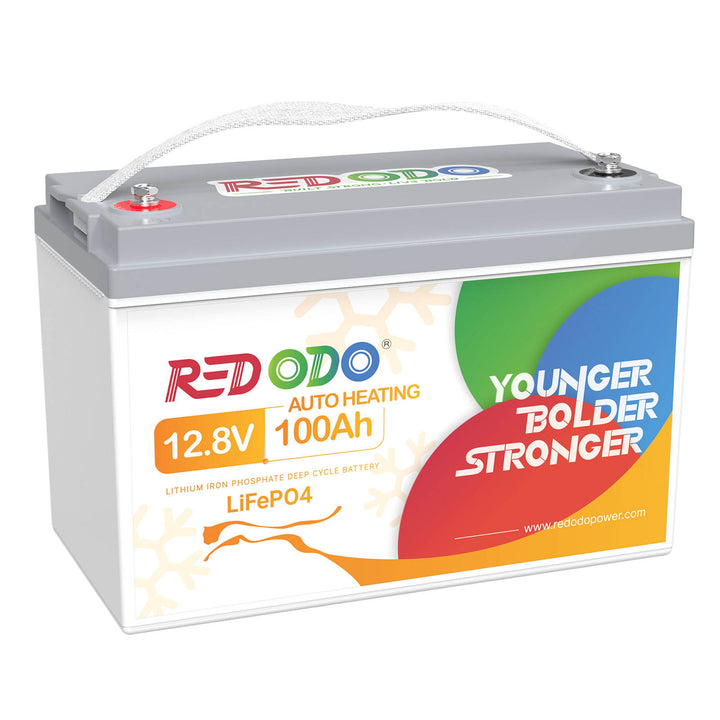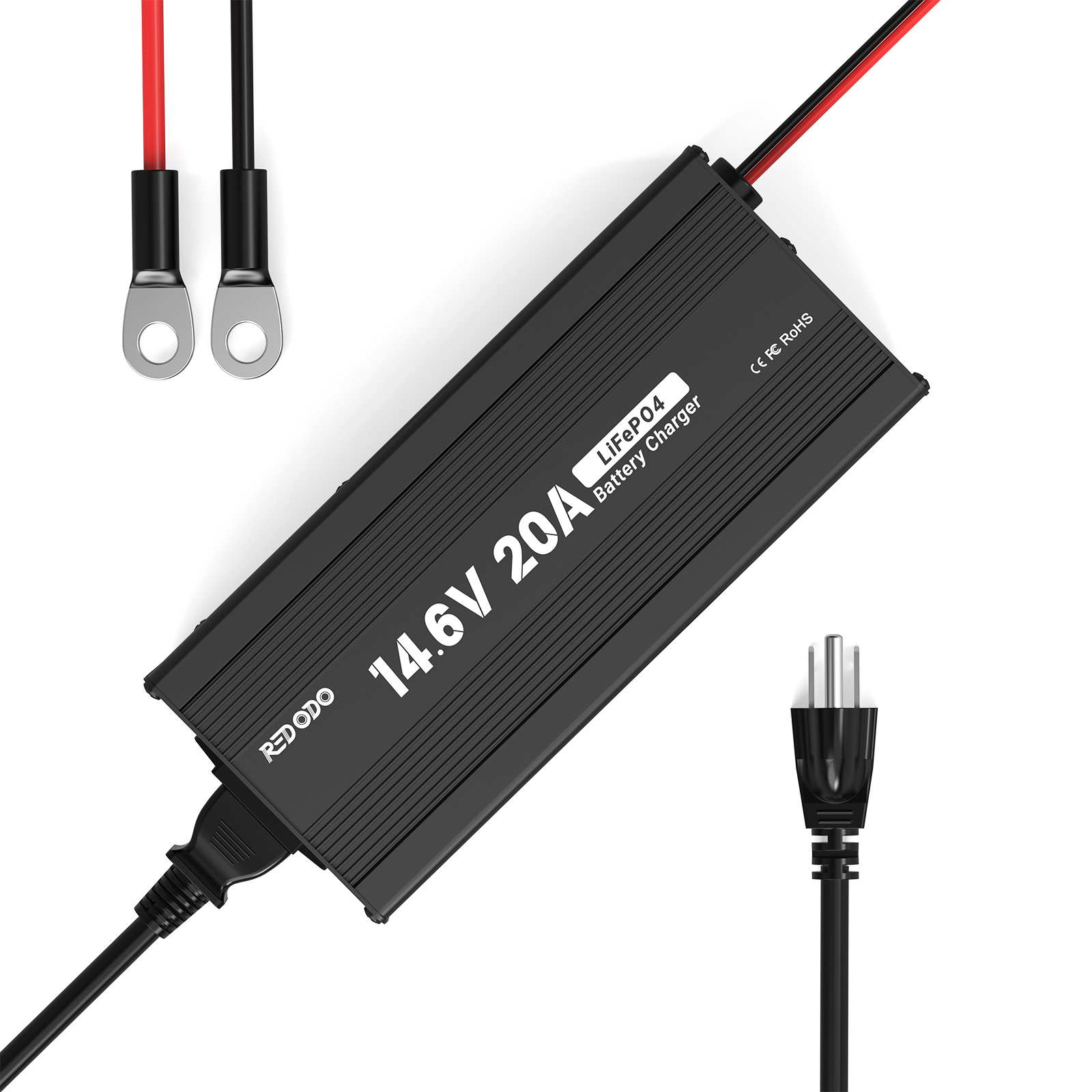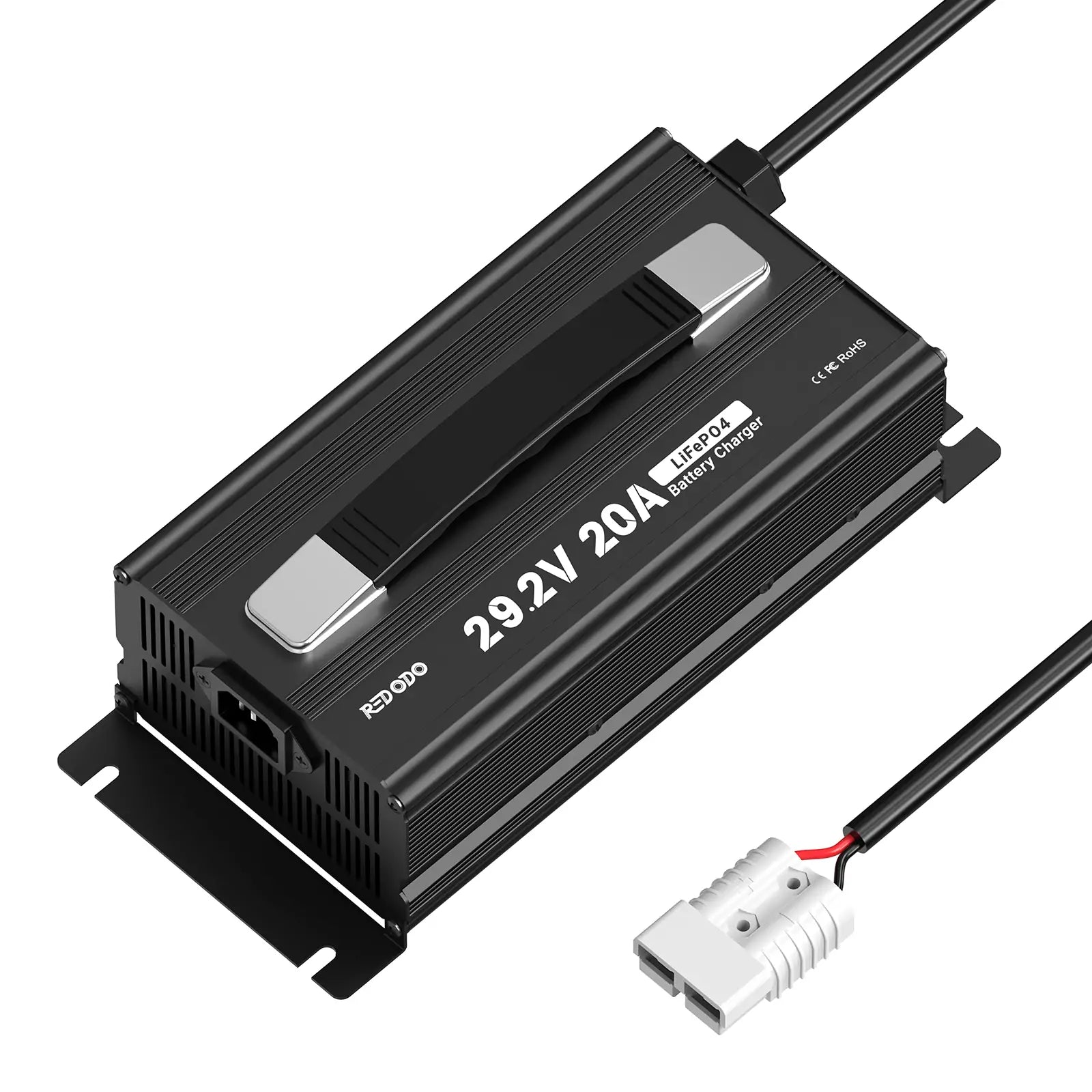[Full Guide] Can I Charge LiFePO4 Battery with a Normal Charger?
As the demand for sustainable energy storage solutions grows, LiFePO4 batteries have emerged as a reliable and eco-friendly option. At the same time, the questions “Can I charge LiFePO4 battery with a normal charger” or “Can I charge my LiFePO4 battery with a lead acid charger” are increasingly be asked.
In this article, we will delve into the LiFePO4 battery charging logic and why Redodo doesn’t recommend using lead-acid charger to charge LiFePO4 batteries.
Table of Content
LiFePO4 Battery Charging Logic
The inherent properties of the LiFePO4 battery dictate a distinct charging profile, setting it apart from traditional lead-acid counterparts. The LiFePO4 battery exhibits a simplified charging process and mode, rendering it advantageous for your charging preferences. Hence, it is advisable to opt for the LiFePO4 charging method.
1.LiFePO4 Charging Mode
Take charging Redodo 12V 100Ah mini for example.

CC (Constant Current) Phase (T1)
In the beginning, a discharged battery will be charged with a constant current and voltage will be climbing steadily until reaching the constant voltage setpoint which varies for different charging methods.
CV (Constant Voltage) Phase (T2)
The battery maintains a constant voltage during this phase while the current gradually decreases to 2A (0.02C) which is also known as tail current. At this point, the charging is cut off and the battery is fully charged.
Tail Current(A) = Battery Capacity*0.02C E.g., 100Ah*0.02C=2A tail current.
2.Lead Acid Charging Mode
Bulk/Boost Phase (T1)
At the onset, a discharged battery undergoes charging with maximum current, gradually ascending towards the absorption voltage setpoint. During this phase, reminiscent of the LiFePO4 battery's CC phase, voltage steadily rises.Absorption Phase (T2)
Once the battery reaches the absorption voltage setpoint, it maintains a constant voltage while the current gradually diminishes, leading to near-full capacity (around 10-20% remaining). Generally, the absorption phase lasts no longer than 3 hours to avert overcharging. This phase corresponds to the CV phase in LiFePO4 battery charging.Float Phase (T3)
Following the absorption stage, the battery's voltage reduces to the float voltage setpoint, accompanied by a decline in current to a lower maintenance mode. This safeguards against self-discharging and offsets any potential power loss. In cases where the battery experiences heavier discharge, the controller may revert to the Bulk/Boost or Absorption phases to replenish the expended energy while an energy source is available. It's important to note that the LiFePO4 battery does not incorporate this particular charging phase.
Therefore, we do not recommend using lead acid charger to charge lifepo4 battery beacuse its charging profile is not optimized for the LiFePO4 chemistry. Using a lead acid charger may result in suboptimal charging efficiency and could potentially lead to damage or reduced lifespan of the LiFePO4 battery.
3 Recommended Ways to Charge LiFePO4 Batteries
1.Using Solar Panels
Harnessing the abundant power of the sun, solar panels offer a renewable and sustainable method for charging LiFePO4 batteries. Utilizing photovoltaic cells, solar panels convert solar energy into electrical energy, providing a direct source for battery charging or storage in a separate energy storage system. When selecting solar panels for charging LiFePO4 batteries, it is crucial to consider factors such as wattage, efficiency, weather conditions, and installation requirements. It is also advisable to incorporate a charge controller to prevent overcharging and enhance the charging process.
For instance, a 12V 100Ah LiFePO4 battery can be efficiently charged using 300W solar panels, allowing the battery to reach full capacity in just one day, considering effective sunshine of approximately 5 hours per day.

Check out Redodo Solar Charge Controller to make sure your batteries charge efficiently.
2.Using Alternator/ Generator
In circumstances where access to electricity is limited, such as during outdoor endeavors or in remote locales, generators can serve as a splendid choice for charging LiFePO4 batteries.
When employing an alternator or generator to charge your LiFePO4 battery, it is imperative to ensure harmonization between the charging voltage and current with the specifications of your battery. Introducing a DC-to-DC charger between the battery and the generator becomes obligatory if the alternator or generator supports DC output.
This arrangement guarantees that the LiFePO4 battery receives the appropriate charging conditions, mitigating the risk of any potential damage.
Redodo's LiFePO4 batteries can be charged using an alternator or generator, bestowing a flexible charging option for an array of power sources.

3.Using LiFePO4 Battery Charger (Most Recommended)
Utilizing LiFePO4 battery chargers emerges as the epitome of efficiency and convenience in the domain of LiFePO4 battery charging. These chargers are thoughtfully engineered to cater specifically to the nuances of LiFePO4 chemistry, ensuring an optimal amalgamation of charging performance and safety.
They provide meticulously calibrated voltage and current levels, meticulously tailored for impeccable charging efficacy while assiduously safeguarding the integrity of the battery cells. LiFePO4 battery chargers often showcase a host of advanced functionalities, including but not limited to overcharge protection, temperature monitoring, and automatic shut-off, all of which serve to further augment the longevity and safety prowess of the batteries.

(Redodo 12V/24V LiFePO4 Battery Charger)
Kindly refer to the table below for comprehensive insights into the voltage specifications pertaining to diverse LiFePO4 battery packs and systems.

Tips for Charging:
- Prior to connecting the charger to the grid power, it is advisable to first connect it to the battery to avoid any potential sparks.
- Once the battery has reached full charge, it is recommended to disconnect the charger from the battery.
Charging LiFePO4 Batteries in Cold Temperatures
The optimal temperature range for the safe charging of LiFePO4 batteries is between 0°C and 45°C (32°F and 113°F).
Cold environments pose unique challenges when it comes to charging LiFePO4 batteries. We will address these challenges and introduce Redodo's self-heating series batteries as a practical solution. By exploring this innovative technology, we offer readers a way to overcome cold temperature limitations and harness the full power of their LiFePO4 batteries.

FAQs about Charging LiFePO4 Battery
1.How do I store lithium iron phosphate (LiFePO4) battery?
To store a LiFePO4 battery safely, follow these guidelines:
- Charge the battery: Before storage, ensure the battery is charged to around 50-60% of its capacity. This level helps to maintain its overall health during storage.
- Choose an appropriate location: Store the LiFePO4 battery in a cool, dry place away from direct sunlight, extreme temperatures, and sources of heat. Avoid areas prone to moisture or humidity. Ideally, the temperature range should be between 0-25°C (32-77°F).
- Disconnect any loads or devices: Make sure to remove any connected devices from the battery before storage. This helps to prevent accidental discharge and prolongs the battery's lifespan.
- Inspect the battery: Before storing, inspect the battery for any damage, leaks, or abnormalities. If you notice any issues, it's advisable to consult the manufacturer or a professional for guidance.
- Avoid long-term storage: If possible, avoid storing LiFePO4 batteries for extended periods without periodic use or charging. Regular use and charge cycles help maintain the battery's performance and health.

- Recharge periodically: If you need to store the battery for a prolonged period without use, it is recommended to recharge it every three to six months to maintain its capacity. This helps prevent the battery from fully discharging and potentially becoming permanently damaged.
Always consult the specific instructions provided by the manufacturer for the best storage practices for your particular LiFePO4 battery.
Learn More: A Comprehensive Guide on How to Store LiFePO4 Batteries
2.Can I install an LiFePO4 battery on its side?
It is generally not recommended to install a lithium battery on its side. Lithium batteries are typically designed to be installed and used in an upright position. Installing them on their side could potentially lead to leakage, overheating, and even safety hazards. It is always best to consult the manufacturer's instructions and guidelines for proper installation and use of lithium batteries.
However, you can install the Redodo 12V 100Ah mini battery on its side. You can mount it any direction, even up side down.
3.Are LiFePO4 battery safe?
Yes, LiFePO4 (Lithium Iron Phosphate) batteries are generally considered to be safe. They are known for their superior safety features compared to other lithium battery chemistries like Lithium-ion (Li-ion) or Lithium Polymer (LiPo).
LiFePO4 batteries have a stable chemical structure that is less prone to thermal runaway, which is the main cause of battery fires or explosions in other lithium battery types. They also have a higher thermal stability, meaning they can withstand higher temperatures before experiencing any issues.
However, it's important to note that no battery is completely risk-free. Proper handling, charging, and storage practices must always be followed to ensure the safe and optimal use of LiFePO4 batteries.
Conclusion
Can I charge LiFePO4 battery with a normal charger? The answer is not recommended. Using a normal charger, especially a lead-acid charger, may result in suboptimal charging efficiency and potential damage to the LiFePO4 battery. It is recommended to use LiFePO4 battery chargers specifically designed for this battery chemistry.
These chargers provide calibrated voltage and current levels, ensuring optimal charging and safety. Additionally, other charging methods like solar panels and alternators/generators can also be used, but it is important to ensure proper voltage and current matching with the LiFePO4 battery specifications.
If you have any questions regarding LiFePO4 battery, please don't hesitate to send us an email by service@redodopower.com. Join our community or subscribe our newsletters to get more expert tips and the latest discount!
![[Full Guide] Can I Charge LiFePO4 Battery with a Normal Charger?](http://www.redodopower.com/cdn/shop/files/20220402-182128_f406e536-af3b-484f-ba7c-2f4771ec4559.png?crop=center&format=webp&height=24&v=1656668006&width=24)
Redodo
![[Full Guide] Can I Charge LiFePO4 Battery with a Normal Charger?](http://www.redodopower.com/cdn/shop/files/20220402-182128_f406e536-af3b-484f-ba7c-2f4771ec4559.png?crop=center&format=webp&height=24&v=1656668006&width=24)
Redodo
Join Redodo
Related Post

Light Up Your Christmas with Redodo: LiFePO4 Batteries Holiday Deals

How to Choose the Best Battery for Van Life?

What Size Battery Do I Need for a Travel Trailer?

36V vs. 48V Battery for Golf Cart: Which Is Better?








